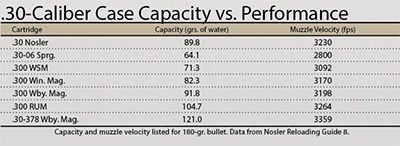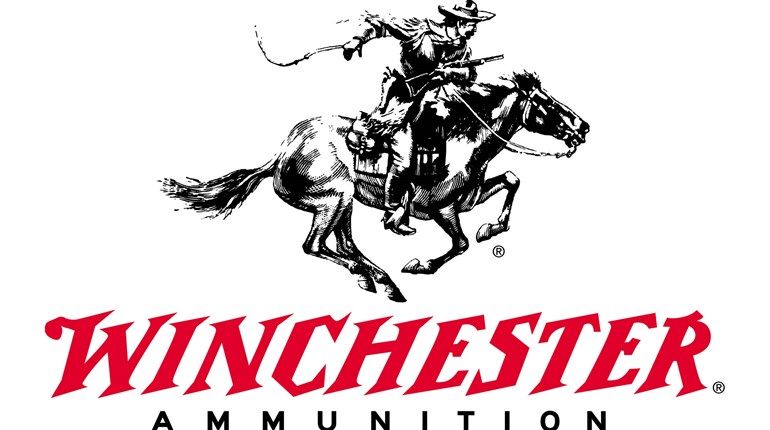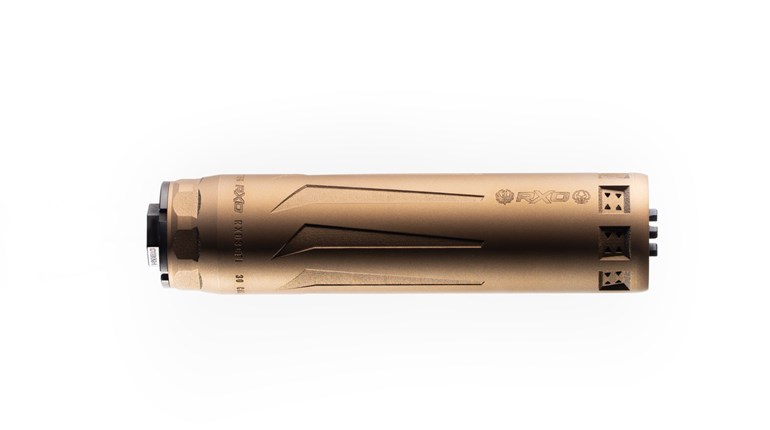
Nosler didn’t build its latest cartridge for jump-shooting whitetails in the woods. Pushing a 180-grain AccuBond bullet at 3200 fps and a 210-grain AccuBond Long Range with an extremely high ballistic coefficient at 3000 fps, the new 30 Nosler is clearly aimed at elk, moose, big bears, large African antelope and any big game at extreme range.
Given the plethora of .30-caliber magnums in the marketplace, one might ponder why an ammunition manufacturer would find it necessary to design another. Nosler’s reply to that appears to be “balance.” According to Nosler’s claims, this fat, beltless case combines the best of all .30-caliber magnums. It fits standard-length (.30-06 Sprg.) actions like the .300 Win. Mag., exceeds the velocity of the .300 Wby. Mag. with slightly less recoil, headspaces on the shoulder like the .300 RUM, and approaches the efficient powder column of the .300 WSM.
So maybe we should call this the .30 Goldilocks. Not too short, not too long, not too fast, not too slow, not too much recoil—just right. To test these possibilities, I ordered a Nosler M48 rifle chambered for 30 Nosler and a few boxes of Nosler Trophy Grade factory ammunition to test drive.
The dual-lug, push-feed M48 rifle has been around in various configurations for a decade. The latest version is the sleek, composite-stock Liberty with a Cerakote finish, an aluminum bedding chassis and a free-floating, 26-inch barrel. My test rifle shipped with a mounted and zeroed Leupold VX-6 3X-18X-50mm scope with CDS turret. This clearly marked turret makes long-range dialing dead simple. The engraved numbers represent the range. Dial 4 to be dead on at 400 yards, 6.5 for 650 yards, etc. CDS dials are custom-built for each shooter’s specific rifle, load and trajectory—in this case, the 30 Nosler 180-grain AccuBond factory load in the M48 Liberty.
The 30 Nosler case is built on the same basic chassis Nosler used for its 26 and 28 Nosler: a shortened .404 Jeffery with a rebated rim, straightened walls and a 35-degree shoulder. Base-to-shoulder length of the 30 is slightly less than that of the 26 to provide a full-caliber neck to grip the .308-inch bullet. Case capacity is 89.8 grains of water. To put that in perspective, see chart.
Nosler Reloading Guide 8 lists the top-speed 180-grain .30 Nosler load as 87 grains of Retumbo at 3230 fps. (This is a maximum, compressed load.) The 180-grain AccuBond factory load averaged 3100 fps over my Oehler 35P chronograph set 15 feet beyond the muzzle of the M48. Nosler’s recipe for top speed with the 210-grain AccuBond Long Range is 79 grains of RL26 (another maximum load) netting 3017 fps. The Oehler clocked the 210-grain factory load at an average velocity of 2978 fps.
According to Nosler’s ballistic charts, the 180-grain AccuBond zeroed at 200 yards should drop just 5.6 inches at 300 yards and 16.2 inches at 400, beating all .300 magnums except the voluminous .300 RUM and .30-378 Wby. Mag. It does this with nearly 10 percent less recoil in rifles of the same weight.
My online ballistic calculator indicates a 180-grain AccuBond starting flight at 3230 fps and zeroed at 275 yards will peak 3 inches high at 150 yards and not fall 3 inches below line-of-sight until 320 yards. That’s maximum point-blank range for game as small as a coyote. Wind deflection at 300 yards in a 10 mph right-angle blow will be just 5.4 inches. For the 24-inch chest of a bull elk you could zero dead-on at 310 yards, peak 4.24 inches high at 175 yards and drop just 7.8 inches at 400 yards.
With a laser rangefinder and the Leupold CDS dial, maximum point-blank range may be less of a concern. Precision targeting is simple at any distance out to 900 yards. Still, it’s nice to know the 180-grain AccuBond is carrying 1500 foot-pounds of energy at 725 yards. Of course, reliably hitting targets at such extended ranges is anything but guaranteed thanks to variable wind speeds, changing temperatures and unpredictable air pressure.
Personally, I wouldn’t hunt with 180-grain bullets in the 30 Nosler unless I had no interest in shooting past 300 yards. Beyond that, the 210-grain AccuBond Long Range really shines. With a ballistic coefficient (BC) of .730, this sleek heavyweight will deflect just 7 inches at 400 yards in a 10 mph right-angle wind. It will carry 1500 foot-pounds of kinetic energy slightly beyond 1,000 yards. Big, high-BC bullets like this have the most potential for taking advantage of the powder capacity of the nicely balanced 30 Nosler, another superb option in America’s .30-caliber arsenal.
Technical Specifications:
• Caliber: .30
• Bullet: 180-gr. Nosler AccuBond, 210-gr. Nosler AccuBond Long Range
• Ballistic Coefficient: .507 (180 gr.), .730 (210 gr.)
• Muzzle Velocity (advertised fps): 3200 fps (180 gr.), 3000 fps (210 gr.)
• Muzzle Energy (advertised ft.-lbs.): 4092 (180 gr.), 4196 (210 gr.)
• MSRP: $75-$79 per 20-rnd. box






































